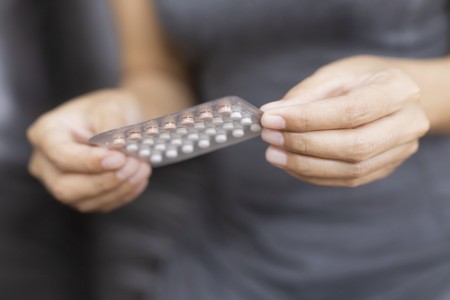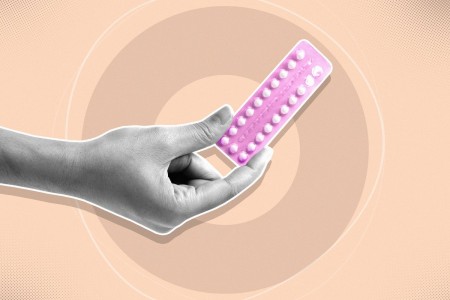
Advertisements
Polycystic ovary syndrome (PCOS) is a hormonal disorder, but the condition — which may affect up to a quarter of people assigned female at birth (AFAB) globally, per June 2020 research in Progress in Preventive Medicine — is also connected to fertility, metabolism and even heart, skin and mental health.
Video of the Day
In other words, PCOS is complicated. But the more we understand about the disorder, the better we can become at treating it and improving quality of life for those who have it.
Here's a deeper look at PCOS statistics, including who PCOS affects, how it's diagnosed and how it's linked to other health conditions.
Diagnosing PCOS
One tricky thing about PCOS is its diagnosis. The reason? There are three different criteria used, according to the June 2020 study in Progress in Preventive Medicine, which can lead to inconsistencies in who's diagnosed and when.
The three main criteria are:
1. Hyperandrogenism: This refers to an excess of the hormone androgen, which can lead to either excessive hair growth on the face, chest and back or hair loss (called hirsutism); acne; weight gain; and developing other biological-male characteristics (called virilization). It's considered the "hallmark" feature of PCOS, according to a November 2019 article in the Egyptian Journal of Medical Human Genetics.
2. Chronic oligo-ovulation or anovulation: About 95 percent of people with PCOS experience some type of anovulation, which means a lack or absence of ovulation. Ovulation is the release of an egg from the ovaries, which results in pregnancy if the egg is fertilized or menstruation if it's not. These people might have abnormal uterine bleeding due to ovulatory dysfuntion, usually marked by fewer than eight periods in one year, or amenorrhea, which means no period for more than three months.
3. Polycystic ovaries: About 90 percent of people with PCOS who have excess hair growth also have multiple cysts on their ovaries, according to a December 2013 article in Clinical Epidemiology. It's important to note here that just because you have cysts on your ovaries, this doesn't mean you have PCOS. Indeed, later in the same article, the authors report that 20 to 30 percent of people AFAB who don't meet the medical criteria for PCOS have multiple ovarian cysts.
In order to make a PCOS diagnosis, doctors must rule out other related disorders, such as Cushing's syndrome (which can cause all three diagnostic criteria, as well as insulin resistance) and androgen-secreting tumors.
Is PCOS Genetic?
About 24 percent of people with PCOS had a mother with PCOS, and 32 percent had a sister with the condition, according to a January 2001 study in Fertility and Sterility. PCOS is considered an ancient disorder passed down through families, and it's likely that a variety of genetic components contribute to it.
Advertisements
Worldwide Prevalence of PCOS
Because people with PCOS can have a wide range of symptoms and because doctor education on the condition is relatively lacking, it's likely that PCOS is under-diagnosed. In fact, it's estimated that 50 to 75 percent of people with PCOS don't know they have it, according to a November 2018 paper in the International Journal of Environmental Research and Public Health.
With that in mind, somewhere between 6 and 26 percent of people AFAB worldwide are estimated to have PCOS, per the June 2020 study in Progress in Preventive Medicine.
PCOS Prevalence by Country
Here are the estimated percentages of people AFAB in their reproductive years who have PCOS, keeping in mind that diagnostic methods can vary by country:
- Australia: 12 to 21%
- Canada: 6 to 10%
- Greece (islands): 12.6%
- India: 20%
- Mexico: 6%
- Pakistan: 52%
- Spain: 6.5% in white adults
- United Kingdom: 20 to 25%
PCOS Demographics for the U.S.
Because of the challenges mentioned above, it's difficult to get a clear picture of how many people have PCOS in the U.S. But here are the best estimates:
- Somewhere between 6 and 12 percent of people AFAB in the U.S. havePCOS, according to the Centers for Disease Control and Prevention (CDC), though the actual number may be higher.
- 5 million people AFAB of childbearing age are estimated to be affected, according to the CDC.
- About 1 in 10 people AFAB in their reproductive years have the condition, per the Office on Women's Health.
- PCOS is the most common endocrine abnormality among people AFAB of reproductive age in the U.S., according to a June 2015 article in the International Journal of Endocrinology.
- According to the CDC, PCOS can happen at any age after puberty, but most people find out they have PCOS in their 20s or 30s.
PCOS by Race/Ethnicity
This condition can be seen in people of all races and ethnicities, but research shows that some groups are more affected. There's not a lot of data among larger populations broken down by race or ethnicity. But one July 2017 article in Oncotarget found that the prevalence of PCOS was as follows:
- Chinese: 4.4 to 7.3%
- White: 4.8 to 6.3%
- Middle Eastern: 5.3 to 18.6%
- Black: 5.3 to 7.1%
The Cost of PCOS
Identifying and managing PCOS costs the U.S. health care system $4 billion per year, according to a June 2013 review in Pharmacy & Therapeutics.
PCOS, Fertility and Pregnancy
PCOS is tied to infertility. Here, we'll break down what that means:
PCOS and Infertility
Research shows the infertility rate for people with PCOS is higher than in people without the condition.
- The rate of infertility is estimated to be 15 timeshigher in people with PCOS, according to an April 2015 study in the Journal of Women's Health.
- According to the World Health Organization(WHO), PCOS is the most common cause of anovulatory infertility, when you don't ovulate, or release an egg to fertilize.
- 80 percent of women with anovulatory infertility have PCOS, according to a September 2017 paper in Women's Health.
PCOS and Pregnancy Odds
People with PCOS can get pregnant, but the odds are typically lower because they tend to ovulate less. Here's a closer look at the numbers:
- Infertility drugs can help those with PCOS get pregnant. Clomiphene citrate (CC), a medication used as first-line treatment to induce ovulation, assists about 75 to 80 percent of those with PCOS to ovulate, with a reported conception rate of 22 percent per cycle, according to a December 2019 article in Clinical Medicine Insights: Reproductive Health.
- The clinical pregnancy rate of letrozole, another first-line treatment to induce ovulation, was found to be higher than CC in one February 2014 review of 26 randomized controlled trials in the Cochrane Database of Systematic Reviews.
- Weight loss — specifically, shedding 5 to 10 percent of body weight — might help with re-establishing ovulation and thus getting pregnant, according to a 2015 chapter in A Case-Based Guide to Clinical Endocrinology.
- While it may take people with PCOS longer to get pregnant, family size isn't necessarily reduced compared to thosewho don't have the condition, according to a July 2012 study in Human Reproduction Update.
- PCOS presents a moderate risk of ovarianhyperstimulation syndrome, a potential complication of fertility medications that stimulate egg production, in up to 7.5 percent of people with PCOS who conceiveafter in vitro fertilization (compared to 2.7 percent in people without PCOS), according to the September 2017 paper in Women's Health.
Pregnancy Complications and PCOS
If you have PCOS and get pregnant, you're at an increased risk of the following, according to that same September 2017 study:
- Early pregnancy loss: It's estimated to be three times greater inthose with PCOS.
- Miscarriage: After IVF, miscarriage was reported in about 36 percent ofthose with PCOS (compared to about 24 percent in those without PCOS).
- Gestational diabetes (GDM): One study found a two- to threefoldincrease in GDM in those with PCOS.
- Pregnancy-induced hypertension (PIH) and preeclampsia (PET): Research has found these conditions to occur three to four times more often in people with PCOS.
- Premature delivery: These rates are increased as well, especiallyin those with hyperandrogemia. One study found the rate of premature delivery inthose with PCOS to be 21 percent compared to 12.5 percent in a control group.
- Cesarean sections (CS): Elective and non-elective CS were doubled in a PCOSpopulation compared to a non-PCOS population.
PCOS Comorbidities and Complications Data
Infertility is a big complication of PCOS, yes, but it's not the only major health issue associated with the condition. Research has linked PCOS to a number of health complications. Though researchers aren't sure if PCOS is the cause of these issues or vice vera, or if other conditions cause both, they do know that these are seen often when you have PCOS.
- Higher weight: Somewhere between 40 and 80 percent of people with PCOS condition also have overweightor obesity, according to an April 2007 study in Obesity Management. The relationship between weight and PCOS is complicated, according to the CDC, and more research is needed to understand it.
- Insulin resistance: About 50 to 70 percent of people with PCOS have insulin resistance, according to the International Journal of Environmental Research and Public Health. Excess amounts of glucose and insulin in the blood can lead to metabolic syndrome and type 2 diabetes, according to The Eunice Kennedy Shriver National Institute of Child Health and Human Development.
Here are some health concerns PCOS puts you at higher risk for, according to the CDC unless otherwise specified:
- Diabetes: At least half of people with PCOS will develop diabetes or prediabetes(glucose intolerance) by the age of 40. PCOS has been defined as a nonmodifiable risk factor for type 2 diabetes by the American Diabetes Association, and between 4 and 10 percent of people with PCOS have type 2 diabetes (that's twice the prevalence in age- and weight-matched healthy people AFAB without PCOS), according to the June 2015 article in the International Journal of Endocrinology.
- Cardiovascular disease: PCOS puts you at higher risk for heart disease, and that risk increases with age.
- High blood pressure: If you have PCOS, you're more likely to have high blood pressure, which is a leading cause of heart disease and stroke.
- Unhealthy cholesterol: People with PCOS can have higher levels of LDL (bad)cholesterol and lower levels of HDL (good) cholesterol, raising their heart disease andstroke risk.
- Sleep apnea: This disorder involves breathing interruptions during sleep thatcan raise your risk of heart disease and diabetes.
- Depression and anxiety: People with PCOS are at increased risk for these mental health conditions.
- Endometrial cancer: Problems with ovulation, obesity, insulinresistance and diabetes (all common in people with PCOS) increase the risk ofdeveloping cancer of the endometrium (lining of the uterus or womb).






